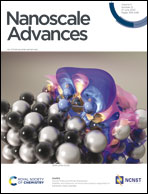Control and regulation of the performance of fullerene-based dye-sensitized solar cells with a D–D–A structure by external electric fields†
Abstract
We investigated the modulating effect of an electric field (Fext) on the photovoltaic properties of triphenylamine-based sensitizers with a D–D–A structure and compared the photovoltaic parameters at different electric field intensities. The results show that Fext can effectively adjust the photoelectric properties of the molecule. From the change of the parameters that measures the degree of electron delocalization, it can be seen that the Fext can effectively strengthen the electronic communication and promote the charge transfer process within the molecule. And the dye molecule under a strong Fext has a narrower energy gap, more favorable injection, regeneration driving force and a larger conduction band energy level shift, which ensures that the dye molecule can exhibit larger Voc and Jsc under a strong Fext. The results of calculations on the photovoltaic parameters of dye molecules show that dye molecules can exhibit better photovoltaic performance under the action of Fext, which provides beneficial predictions and prospects for the development of highly efficient DSSCs.



 Please wait while we load your content...
Please wait while we load your content...